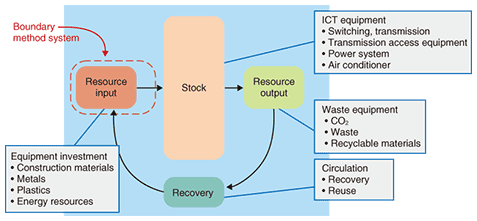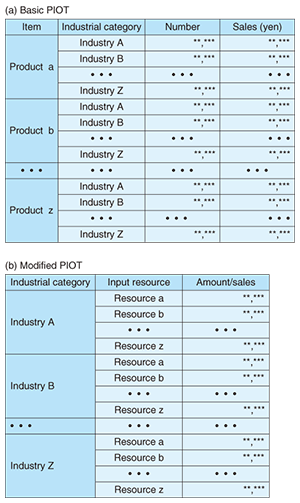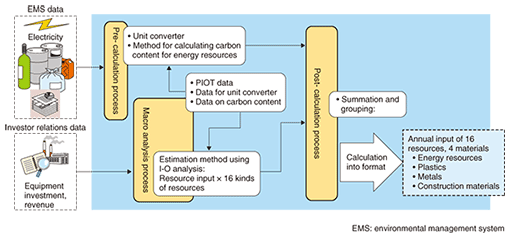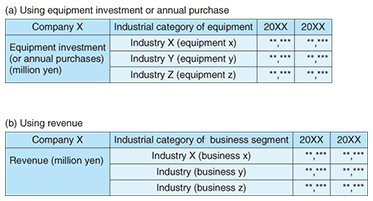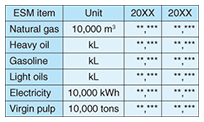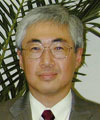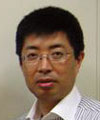 |
|||||||||||
|
|
|||||||||||
|
Feature Articles: Environment and Energy Technologies Toward a Green Society Vol. 9, No. 2, pp. 44–49, Feb. 2011. https://doi.org/10.53829/ntr201102fa7 Algorithm for Estimating Resource Input in ICT IndustryAbstractWe present an algorithm for estimating the input resources consumed in managing equipment used in the information and communications technology (ICT) industry. It helps to produce appropriate plans for avoiding rising procurement costs and reducing the environmental impact of ICT equipment, which will enable us to prepare for the increase in the cost of resources caused by their depletion.
1. IntroductionIn 1999, the NTT Group established the NTT Group Global Environmental Charter describing basic principles and policies for protecting the environment. The NTT Group analyzed achievement levels against specific goals in relation to preventing global warming, reducing waste products, and reducing paper consumption in terms of CO2 emissions, the amount of final waste for disposal, and the consumption of virgin pulp. Along with the rising interest in corporate social responsibility, companies are becoming responsible for their supply chain activities such as procurement and waste treatment. The Global Reporting Initiative in partnership with the United Nations Environment Programme determines materials used by weight or volume as a core performance indicator in their guideline for sustainability reporting [1]. Progressive companies use the results of a material consumption analysis to promote resource savings. For example, several dozen companies disclose their environmental and economic improvements achieved by using material cost flow accounting [2]. The rapid increase in resource costs may have a serious impact on the information and communications technology (ICT) industry in the future because of its resource consumption as a result of its extensive infrastructure. Therefore, the resources required for the ICT industry must be estimated. 2. Material flow analysisMaterial flow analysis (MFA) is a methodology concerned with estimating the total amount, circulation amount, or balance of input and output amounts of materials systematically and quantitatively in entities such as countries and companies. The input represents the consumption of raw materials and energy and the procurement of parts. The output includes products, by-products, CO2 emissions, and waste. The concept of material flow in the ICT industry is shown in Fig. 1.
The Japanese Ministry of the Environment uses MFA to obtain information about current resource circulation. Moreover, it is using MFA results to set numerical targets for resource productivity and cyclical use rate by adding to the conventional target expressed in the amount for final disposal in order to save resources and use appropriate waste treatment with the goal of establishing a sound material-cycle society [3]. 3. Resource input measurement in the ICT industryData collection for productivity management is already under way for the purchase of raw materials, and many manufacturing companies disclose MFA results in relation to their annual activities in sustainability reports. On the other hand, the service and infrastructure industries have some difficulties in managing material input related to product purchasing and infrastructure construction. This is why there have been no case studies estimating the resource input of the ICT industry. With a view to applying MFA to the ICT industry, NTT Energy and Environment Systems Laboratories has investigated an algorithm for indirectly estimating the resource input using input-output analysis (IOA). 4. Outline of IOAToday’s economic activities, namely, the supply of goods and services, consist of production activities performed by interlinked industries. Input-output (I-O) tables provide information about production activities in the form of a matrix that shows how many goods and services are produced and distributed among the industries. IOA is an economic estimation methodology that uses I-O tables. In this study, a physical input-output table (PIOT), which is an application table focusing on materials on the basis of I-O tables and industrial statistics, was used to estimate the resource input. The formats of the basic and modified PIOTs used in this study are given in Table 1.
5. Resource input estimation algorithmNTT Energy and Environment Systems Laboratories has established an algorithm based on a top-down approach for estimating the input resources consumed to build and maintain ICT equipment effectively in the service industries. It is an estimation application of IOA using economic indices such as capital investment and annual purchases. It is important to note that the existing algorithm cannot separate the indirect input of resources consumed in supply chains from the direct input for the service industry. For this reason, its input amount results are defined differently from the input data on an aggregate basis. As shown in Fig. 2, the algorithm consists of three processes: (1) pre-calculation of a set of input data related to the operation of equipment, (2) estimation of the resource input on the basis of IOA using PIOT (macro analysis), and (3) post-calculation including a summation of the pre-calculated and estimated data and allocation of the summation to material groups.
The input data for IOA should be financial data such as annual investments, equipment purchases, or revenue. The input data for equipment operation should be management data related to resource consumption (Table 2), such as the annual consumption of electricity, natural gas, petroleum, and paper aggregated in an environmental management system (Table 3). Using the input data set, the algorithm outputs the annual input of 16 resources grouped into 5 categories (Table 4).
(1) Pre-calculation process The set of input data for resources consumed for ICT operation requires the conversion of units because the consumption is expressed in various units. In this process, each consumption data set is converted into a weight unit by using an equation converter according to the units of the resources. Energy resources such as petroleum and gas are converted to carbon content to avoid inconsistency for data expressed in resource weight and CO2 emissions in CO2 equivalent. (2) Estimation process In the estimation process, the resources input for managing equipment are estimated by IOA using input financial data and PIOT data according to the industrial category for each production activity. Since the PIOT data units vary with the materials, they are converted into weight units using the abovementioned process. (3) Post-calculation process The input resources for operation and equipment provided by (1) and (2) are calculated in an application format that includes summation and grouping into categories. 6. Application of resultsNTT Group companies publish statements of resource input using the estimated data, as shown in Fig. 3. The provided results are also useful for creating a material flow chart (Fig. 4). The input flow in Fig. 4 shows the sum of the resource inputs for both operation and equipment. The output flow shows CO2 emissions and waste, including recovered materials.
7. ConclusionWe have established a top-down-approach-based algorithm for estimating input resources in the ICT industry by using IOA. This algorithm is effective at enabling ICT companies to overview the environmental impact of their business activities. Its results include the indirect resource input in the supply chain. To divide the estimated input into direct and indirect inputs, we are developing an aggregation-based estimation model for accurate analysis of a bottom-up-approach-based algorithm. In further research, we intend to develop a method for estimating stock and output amounts as well as input resources in the ICT industry. References
|
|||||||||||








